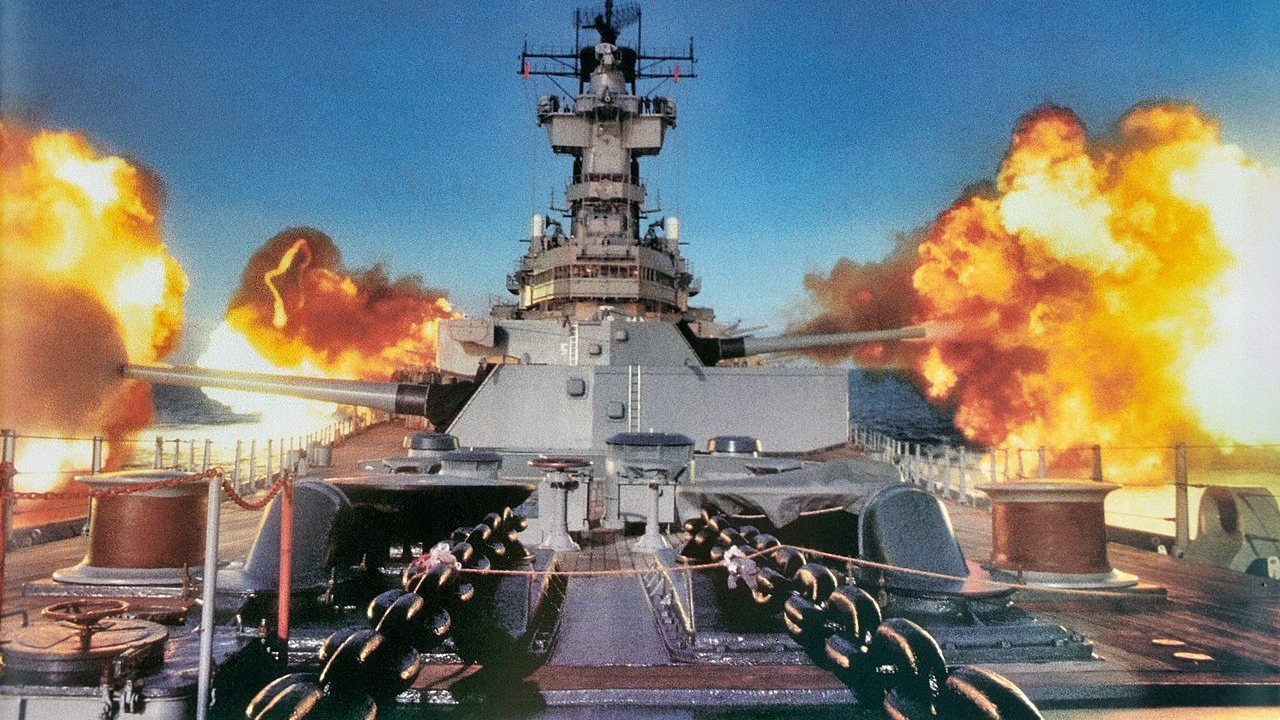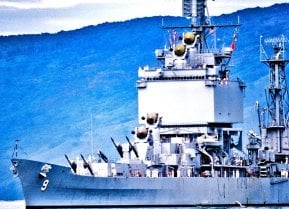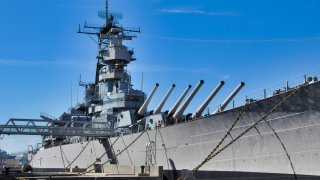The U.S. Navy Can’t Afford a Fleet of “Battleships”?
The USS New Jersey, an iconic Iowa-class dreadnought now serving as a museum ship, is making headlines as it undergoes a significant maintenance phase, including repainting and hull repairs, at the Philadelphia Navy Yard.
Battleships are back in the news thanks to USS New Jersey, an Iowa-class dreadnought now retired as a museum ship in Camden, New Jersey. Last week, tugboats moved New Jersey to a temporary berth as a precursor to drydocking the vessel at Philadelphia Navy Yard for repainting, and for repairing any hull damage discovered once the ship is high and dry.
The ship’s overseers estimate the yard period will take two months. That seems like a mighty ambitious timetable considering the scope of the job—that’s one bulky vessel—and the unknowns regarding the hull’s physical state. New Jersey reportedly hasn’t been out of the water for three decades. Corrosion, sea growth, and other maladies have a way of accumulating with the passage of that much time.
In short, metal and water are not natural companions. They are natural enemies. It takes regular upkeep for a ship’s underwater surfaces to endure—even in the placid surroundings of a maritime museum. Heaven knows what problems will come to light.
One thing Philly shipyard workers will find is that walking underneath a 45,000-ton castle of steel to perform a hull inspection is an awe-inspiring yet unnerving experience. (By the way, that frequently cited figure refers to the ship’s empty weight. Iowas displaced 58,000 tons or thereabouts on active service, when loaded with fuel, ammunition, stores, and of course sailors.) Paranoia verges on inescapable: what if the blocks on which all that mass rests were to shift or collapse?
Squish.
Battleship Revival: How USS New Jersey's Maintenance Sheds Light on Naval Strategy
Anyway. Images of New Jersey underway stir two thoughts, one relating to battleships back then and another relating to the composition of battle fleets today. One, bombast about these behemoths’ supposed invincibility was both commonplace among battleship sailors and misplaced. An oft-heard joke around the Iowa-class held that if an antiship missile were ever to slam home, the captain would simply call away “sweepers.”
The notion being that a ship so stoutly built would suffer no damage in an assault. A cleanup crew would tidy up the mess and ship’s business would carry on.
As with any good jest, there’s a certain amount of truth to it. But only to a point. Sure, parts of a battlewagon boasted armor plating up to seventeen inches thick. Critical sections—the forward faces of the 16-inch gun turrets, for example—could indeed take a wallop. The ship’s engineering plant and other vital innards were encased in an armored box running much of the hull’s length. The sides were thick at the waterline. Etc.

Battleships had to be ruggedly constructed. After all, they were built to duel their heavy-hitting peers on the high seas. They had to be able to take a punch and fight on.
There were limits, though. Much of New Jersey’s superstructure is lightly armored, as are the vessel’s keel and parts of its hull. Antiship munitions could do grave harm to the upper works, while sea mines and torpedoes could smite the relatively soft underbelly. Winston Churchill spotted dreadnoughts’ vulnerability to major-caliber gunfire as early as 1914, long before the inception of the Iowa class. He proclaimed: “The true picture of a battle between modern battleships is not men in armor striking with heavy swords, but a battle between two eggshells striking each other with hammers.”
In other words, offense and defense stood roughly in balance in contests between armor-laden medieval knights. Knights could deal out and withstand heavy punishment in equal measure. By contrast, offense was lopsidedly superior in clashes between armored warships. Who stuck the first effective blow won. And in the age of the submarine, surface patrol boat, torpedo, and mine, light craft could menace capital ships—capital ships being vessels capable of taking and dishing out punishment in action against the toughest warships a foe could put to sea.
Churchill went on to question whether it remained worthwhile to sluice British taxpayers’ money into über-pricey ships of war that appeared unfit for the threat environment they faced. Such worries feel ripped from today’s headlines.
And two, New Jersey offers a reminder of how fleet design has gone awry since the battleships’ heyday. Back then, fleet designers assumed a navy could afford only a few capital ships. They were too big, complex, and pricey to purchase in bulk. Of necessity most of the fleet would consist of smaller, lightweight, less expensive fighting ships optimal for policing the sea, enforcing blockades, and performing the other myriad tasks that didn’t demand battleship firepower or defensive stamina.
The same held true once aircraft carriers supplanted battleships at the core of battle fleets during World War II. Today, for instance, the U.S. Navy deploys just eleven nuclear-powered aircraft carriers. That’s hardly shocking at around $13 billion per copy for the latest model.
But here’s the thing. Apart from carriers, today’s U.S. Navy surface fleet centers around dozens upon dozens of light combatants that also bristle with armament befitting a capital ship. Guided-missile cruisers and destroyers boast ninety or more vertical-launch cells—in essence silos embedded in their main decks. Each cell could pack multiple missiles depending on the ship’s loadout. That’s a potent capability for pummeling hostile navies or targets on dry earth.
Yet all this firepower resides in lightly armored hulls reminiscent of lower-end combatants from the day of the Iowa class. Not for nothing are destroyers dubbed “tin cans.” But they cost a lot these days. They’re supposed to be cheap and plentiful, not expensive and few in number.
So modern naval architecture, perversely, has stacked a major share of the fleet—not just its capital ships per se—with lavish armament, sensors, and fire control, with all of the expense high-tech weaponry entails. The result, as two naval analysts sagely noted of late, is a capital-ship-intensive fleet that’s nigh on too expensive to expand. And naval commanders expect these lightweight combatants—the descendants of World War II tin cans—to bear much of the brunt of sea fights against heavyweight enemy forces.
Nowadays fleet design takes Winston Churchill’s wisecrack about eggshells brandishing hammers to its extreme. And hard-to-afford eggshells at that. Composing a battle fleet that is at once capable and affordable in adequate numbers has become a mindbender thanks to modern technology.
This is not necessarily a critique of navy magnates. It may be that top-heavy fleets have hit their upper limit of affordability. But the cruise of USS New Jersey does hint at why the navy’s struggle to field large numbers of combat platforms at a thinkable price tag has proved so vexing. An auxiliary contingent of inexpensive single-mission crewed warships, uncrewed surface, subsurface, and aerial vehicles, and other novel implements of nautical warfare may help the navy escape its winter of shipbuilding discontent.
One can hope.
About the Author: Dr. James Holmes
Dr. James Holmes is J. C. Wylie Chair of Maritime Strategy at the Naval War College and a Distinguished Fellow at the Brute Krulak Center for Innovation & Future Warfare, Marine Corps University. The views voiced here are his alone.
Image Credit: Creative Commons.


